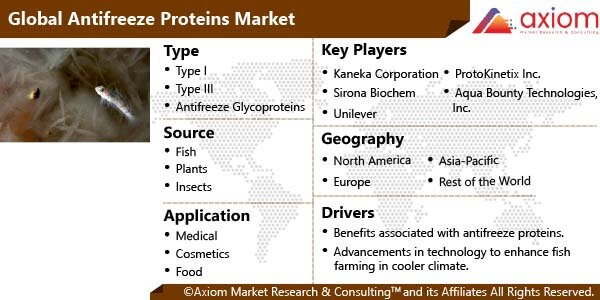Antifreeze proteins are biological antifreezes with unique properties, found in fishes, insects, bacteria and plants in cold climates. They are of varied types but generally follow a similar mechanism of action. These protein bind to ice crystals and subsequently inhibit their growth and recrystallization. There are seven general types have been discovered till date depending on the organisms it has been discovered in and its role in preventing ice crystallization. The antifreeze proteins market is still in its niche stage, with complex processing required for isolation of protein indicating a high financial toll on R&D activities.
Antifreeze Proteins Market Dynamics
The global demand for antifreeze protein is on the rise, particularly in the medical industry. The demand is driven by technological advancements in the field of biotechnology leading to antifreeze protein product development activities for use in medical procedures such as cryosurgery, organ transplant, and vaccines. Moreover improved farm fish production in cooler climates, benefits associated with antifreeze proteins, and their increasing demand of antifreeze protein for cosmetic industries is likely to boost the growth of the market. On the contrast, high cost of production and R&D expenditure and market consolidation are some of the challenges facing by the market.
Antifreeze Proteins Market Segmental Overview
The report analyses the global antifreeze proteins market based on type, source, application and geography.
Antifreeze Proteins Market by Source
Antifreeze proteins are found in a wide range of sources including fish, plants, insects etc. with a specific characteristic structure, but with similar modes of mechanism. The variations with regard to the quality of these sources define the final application of the antifreeze proteins in the different industrial sectors such as food, medical, and cosmetics. For instance, the antifreeze protein derived from the fish source are majorly preferred for cosmetic anti-ageing creams, ice-creams and medical application such as vaccination, organ transplantation etc.
Antifreeze Proteins market by Type
In terms of type, the antifreeze proteins market can be divided into type I, type III, antifreeze glycoproteins, and others The type I antifreeze proteins are found in the body fluids of fish inhabiting polar oceans, are alanine-rich alpha-helical proteins that are able to inhibit the growth of ice. The extraction process of these various types of protein depends on the source. The demand for antifreeze proteins is growing owing to their advance extraction technologies which it suitable for cosmetics and food industries.
Antifreeze Proteins Market by Application
The antifreeze protein market finds application in the field of medical, cosmetic and food. The use of antifreeze protein for medical application helps manufacturers due to the natural source and quality of the product. The high investment for R&D investments from medical and biotechnology companies is likely to boost the market for medical application
In the cosmetic application, antifreeze proteins are used as an additive for preventing quality degradation of cosmetics. For instance, when cosmetics containing an oil component and a fat component are frozen, the water contained in the cosmetics may be crystallised to form ice.
Antifreeze Proteins Market by Geography
Based on geography, the global Antifreeze Proteins market is segmented into North America, Europe, Asia Pacific and Rest of the World. North America accounted for the largest market share owing the owing to the growth of medical and cosmetics industries in this region. Increase in demand for anti-aging products and cryosurgeries boost the antifreeze protein market in North America. The antifreeze proteins market in Asia Pacific is expected to expand at a considerable pace owing to the rise in demand for antifreeze proteins from emerging economies such as China and India.
Antifreeze Proteins Market Key Players
Key players in the global antifreeze proteins market include Kaneka Corporation, Aqua Bounty Technologies, Inc., Sirona Biochem, Unilever, and ProtoKinetix Inc. The antifreeze proteins market is still in its niche stage, with complex processing required for isolation of protein indicating a high investment on R&D activities.











